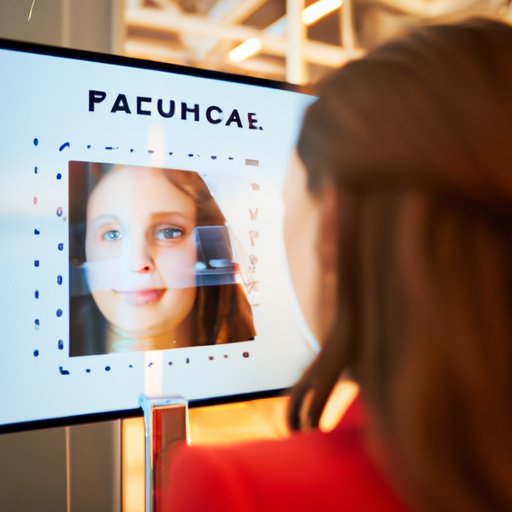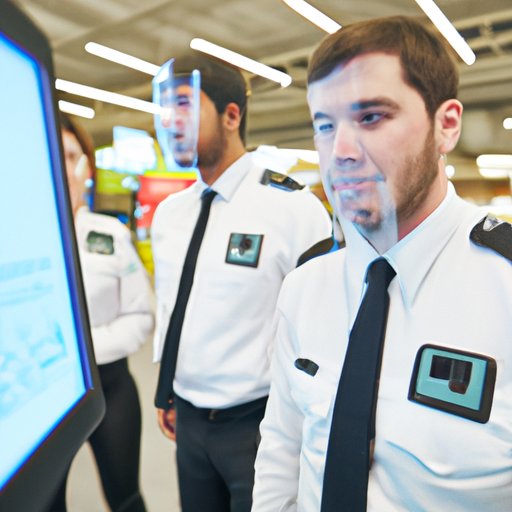Introduction
Facial recognition technology is a biometric identification system that uses an individual’s unique facial features to identify them. This technology has been used in various sectors, from law enforcement to healthcare, and it has been gaining more attention in recent years. In this article, we will explore the use of facial recognition technology, its potential benefits and risks, and potential solutions for protecting consumer privacy.
Exploring the Use of Facial Recognition Technology in Law Enforcement
Facial recognition technology has been used by law enforcement agencies around the world to help identify suspects. According to the American Civil Liberties Union (ACLU), “Law enforcement agencies have been using facial recognition technology to compare people they encounter in the field to photographs in their databases since at least 2010.”
The use of facial recognition technology in law enforcement can be beneficial in some cases. For example, it can help police officers quickly identify suspects and make arrests. However, there are also some drawbacks to using facial recognition technology in law enforcement. For instance, research has shown that facial recognition technology tends to be less accurate for certain demographic groups, such as women and people of color. This can lead to false positives and wrongful arrests.

Exploring the Role of Facial Recognition Technology in Retail Shopping
Retailers have begun to use facial recognition technology to improve customer experience. According to a study by Accenture, “Retailers are increasingly leveraging facial recognition technology to analyze customer behavior, recognize returning customers and personalize offers.”
Using facial recognition technology in retail stores can provide retailers with valuable insights into customer behavior, which can help them better understand their target market and tailor products and services accordingly. Additionally, facial recognition technology can be used to recognize returning customers and offer them personalized discounts or promotions.
Evaluating the Impact of Facial Recognition Technology on Privacy
While facial recognition technology can be beneficial in some contexts, it also poses some risks to consumer privacy. According to the Electronic Frontier Foundation, “Facial recognition technology raises serious privacy concerns because it enables companies and governments to track people without their knowledge or consent.”
Facial recognition technology can be used to collect and store personal information about individuals, which can then be sold to third parties. Additionally, facial recognition technology can be used for surveillance purposes, which could lead to increased monitoring of individuals and their activities.
To protect consumer privacy, it is important for organizations using facial recognition technology to develop robust privacy policies and procedures. Additionally, consumers should be aware of how their data is being collected, stored, and used, and they should take steps to limit the amount of personal information they share online.

Examining the Potential Benefits of Facial Recognition Technology in Healthcare
Facial recognition technology has the potential to revolutionize the healthcare industry. According to a study by the Harvard Business Review, “Facial recognition technology can be used to accurately identify patients, reduce medical errors, and automate administrative tasks.”
Using facial recognition technology in healthcare can help healthcare professionals quickly and accurately identify patients, reducing the risk of medical errors. Additionally, facial recognition technology can help automate administrative tasks, such as checking in patients, scheduling appointments, and filing insurance claims.

Investigating the Use of Facial Recognition Technology in Social Media Platforms
Social media companies have also begun to use facial recognition technology to improve user experience. According to the Pew Research Center, “Some social media platforms are using facial recognition technology to suggest tags when users upload photos or videos.”
Using facial recognition technology in social media can help users quickly find photos and videos of themselves or their friends. Additionally, facial recognition technology can be used to detect offensive content and protect users from harassment or abuse.
Analyzing the Effectiveness of Facial Recognition Technology for Security Purposes
Organizations have also begun to use facial recognition technology for security purposes. According to the International Association of Privacy Professionals, “Organizations are increasingly turning to facial recognition technology to verify the identity of employees, customers, and visitors.”
Using facial recognition technology for security can help organizations quickly and accurately verify the identity of individuals. Additionally, facial recognition technology can be used to detect suspicious activity and deter potential criminals.

Assessing the Use of Facial Recognition Technology in Airport Security
Airports have also begun to use facial recognition technology to improve security. According to the Transportation Security Administration (TSA), “Airports are using facial recognition technology to help identify travelers and match them to passport and visa photos.”
Using facial recognition technology in airports can help reduce the time travelers spend waiting in line, as well as reduce the risk of human error. Additionally, facial recognition technology can be used to detect fraudulent documents and prevent potential terrorists from entering the country.
Conclusion
In conclusion, facial recognition technology has become increasingly popular in recent years, and it has been used in a variety of sectors, including law enforcement, retail shopping, healthcare, social media, security, and airport security. While this technology can be beneficial in some contexts, it also poses some risks to consumer privacy. To protect consumer privacy, organizations should develop robust privacy policies and procedures, and consumers should take steps to limit the amount of personal information they share online.
Overall, facial recognition technology has the potential to revolutionize many industries, but it is important to consider the potential benefits and risks before implementing this technology. By understanding the potential implications of this technology, organizations can ensure that they are using it responsibly and ethically.
(Note: Is this article not meeting your expectations? Do you have knowledge or insights to share? Unlock new opportunities and expand your reach by joining our authors team. Click Registration to join us and share your expertise with our readers.)
